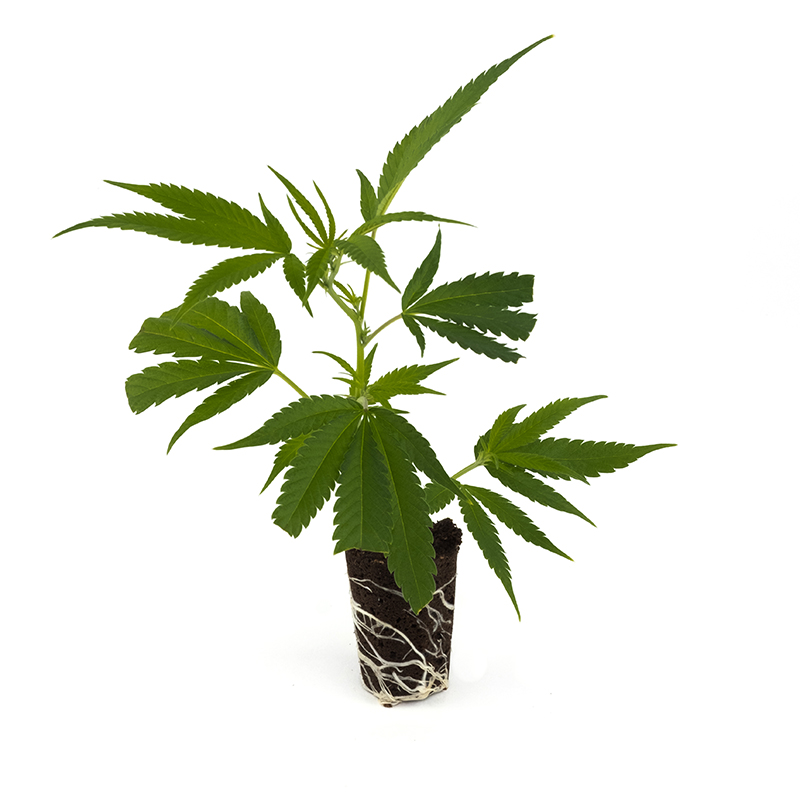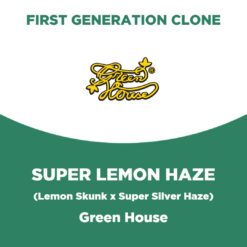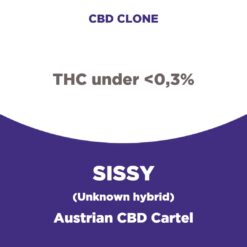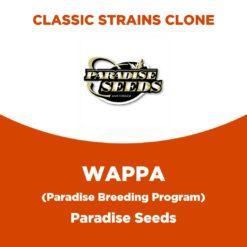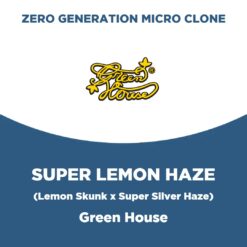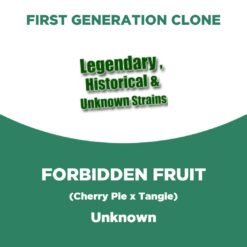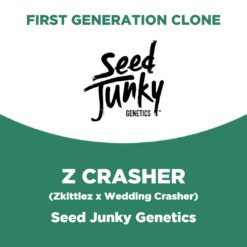White Widow | Dutch Passion | Classic Strains Clone
Da €30,00
White Widow | Dutch Passion | Classic Strains Clone
White Widow is mainly known for her potent all-white buds that make the high so incredibly potent. In terms of fragrance and flavor profile, White Widow can best be described as spicy and piney, with many different underlying notes enhancing the aroma.
In some phenotypes, this will be a citrus undertone, with sour, fresh and fruity characteristics. In others, it may move more towards the diesel end of the spectrum, making her smell a bit more gaseous or metallic.
All in all, this unique and complex aroma falls particularly more under the heading of real old-school weed!
Characteristic:
- Indica / Sativa: 20%-80%
- Days: 55/60
- Cross: Brasilian x Indian
Attention: the availability of our clones is subject to variations during the year, to be guided in your purchase write to us at info@greencountry.biz before confirming the order, we will send you the updated list with the available genetics. Thank you!
White Widow | Dutch Passion | Classic Strains Clone
White Widow is a true legend. Not only for the high quality of the buds, but also for the ease of growth. It is a strong hybrid that will grow vigorously during both veg and flowering. It is a plant that is very suitable for beginners, it does not matter which growing method and cultivation system you want to use.
Her fast flowering time also means that as a grower you don’t have to wait long before you can harvest. With an average flowering time of about 8 weeks, this strain falls into the category of fast flowering plants. Due to her average stretch during flowering she can do well in both a SOG and a SCROG setup.
Dutch Passion’s White Widow had been perfected many years before most of today’s seed companies were even established. True White Widow aficionados will happily pay a little more to get true 1980 F1 White Widow genetics, with the authentic aroma, flavor and unmistakable high.
Our original White Widow is a cross between Brazilian and Indian strains and has a powerful and pungent scent. We believe that our version is the most authentic on the market. Our customers love Dutch Passion’s original White Widow and report great growing results indoors and outdoors (in warm climates) and in greenhouses.
White Widow is a medium sized hybrid cannabis variety with very compact buds. The buds typically produce fewer orange coloured pistils than most cannabis strains. It is the excellent resin production that has made this strain so famous, it can be seen even on the larger fan leaves. White Widow owes its name to this extremely high resin production with its exceptionally thick white layer of trichomes.
White Widow is not a difficult plant to grow. With the right environment and care, she will grow into a beautiful plant that will richly reward you with a good harvest. She is suitable for any type of grow, but thrives best in a controlled indoor grow. The branches are strong enough to bend / snap or “scrog”. White Widow has a medium internode distance and her buds have a very favourable flower-to-leaf ratio. Large buds are only surrounded by small leaves that are easy and quick to remove, which significantly increases the speed of cutting/trimming.
White Widow has average stretch for a hybrid cannabis plant. She continues to grow in the flowering phase for around 2.5 to 3 weeks. Plants are known for their vigorous growth and beautiful full buds packed with glittering trichomes. Trichome production starts quite early in flowering and continues at a rapid pace. It’s no coincidence that this strain is still considered one of the strongest and most potent cannabis strains. Due to its high potency, it is appreciated by both medical and recreational users all over the world.
What To Do When You Receive Your Clones of White Widow?
1. TRANSPLANT
We highly recommend transplanting into the soil or medium that suits your system as soon as you receive your clones. If necessary, they can remain in their “Blisters” for a day or two without allowing the Rockwool/RootRiot to dry out.
We recommend transplanting clones into a 1.5-2 liter pot so that they can form a solid root and sturdier plant structure before being placed in their final pot. Immediately transplanting them into a pot that is too large can cause root rot to develop and slow or hinder the growth of your plant. This will help harden them off and establish themselves before they are transplanted into their final pot.
2. ACCLIMATATION
Acclimating clones to their new environmental conditions is essential to growing a healthy plant and having a successful cycle. While at the nursery, the clones are kept under a 24-hour light cycle. We recommend keeping them on at least an 18/6 light cycle (18 hours light and 6 hours dark) after receiving them. While in the cloning facility, they are kept at 21-24 degrees Celsius and a relative humidity of 69-75%. A slight decrease in temperature and humidity can be accomplished within a week to allow your clones to adapt to your grow room environment.
Acclimating clones to non-direct light is essential to avoid stress. Full intensity of sun or lamps can damage a younger clone/plant, so you will need to decrease the light intensity. The best way to do this is to use a greenhouse, physically move them in and out of the structure, or place shade netting (30-40%) over them for this adjustment period. The acclimation phase should only take a week or two and should be enough time to remove the shade or be moved out of a greenhouse to full light exposure. Maintaining a constant flow of air on your plants will help harden them to the natural conditions found outside and will help make the stems much stronger overall.
3. IRRIGATION AND NUTRITION
Overwatering clones is a very common mistake. It is essential to give your clones a healthy amount of water, but do not oversaturate them by submerging them. A dry-down period is necessary for clones. To determine the moisture content of the soil when the pot is light, squeeze a small handful of medium and observe if water drips. If no water is coming out, it’s a great time to give them a healthy watering without over saturation. This watering method allows the roots to search the pot for water/nutrients creating a sturdy root ball.
If you have some clones that are still showing stress after transplanting up to three days later, you can give them some water again, but you’ll want to make sure the Rockwool/RootRiot itself is moist. Sometimes, even if the soil is moist, the cube will dry out and water must be applied exclusively to the cube. You need to find a good balance between letting the clones dry out without allowing the foliage to show signs of stress. This can cause health problems for your clones.
Clones can be fed every other day a vegetative feed between 1100-1400 PPM depending on how quickly they are assimilating nutrients (NOTE: each strain is different). How often you need to feed them will depend on the type of growth you have (i.e., inorganic, organic, synthetic, hydro, soil, etc.).
FAQ
WHICH GENETICS ARE AVAILABLE?
Genetics marked as “available” are ready to ship on schedule. Genetics listed “not available” can be pre-ordered by sending us a request to info@greencountry.biz and will generally be available in 15/21 days.
WHAT ARE THE SHIPPING AND DELIVERY TIMES?
If the genetics are marked as “available” shipping times can vary from 2 to 5 working days (to ensure that your clones do not remain stuck in courier warehouses, shipments are made by Wednesday of each week).
HOW ARE CLONES SHIPPED?
We ship our clones in special blisters for transporting the plants.
ARE CLONES FEMINIZED?
Yes, all our clones are taken from female mother plants.
HOW BIG ARE THE PLANTS I WILL RECEIVE?
Our clones have a height that varies from 13cm to 25cm.
HOW DO I KNOW THE CLONES ARE PARASITE-FREE?
Our plants are prepared and grown with strictly controlled practices both in the greenhouse and in the laboratory in environments free of plant parasites. We only use chromotropic traps and predatory insects to defend the cultivation spaces.
WHAT IS THE “RECIPE” THAT MAKES THE CLONES HIGHER LEVEL?
Mother plants are constantly regenerated through tissue culture so you always have fresh clones at peak vigor. Once the clones have been taken from the mother plants, they are left to root in a peat/coconut mixture, supplemented with a mixture containing natural plant hormones, basic micro/macronutrients and vitamins.
DOES TISSUE CULTURE ELIMINATE “GENETIC DRIFT”?
Genetic drift, also known as clonal degradation, is a phenomenon typically caused by a variety of factors that can include poor cultivation practices, stress due to abiotic factors (light, heat, fertigation), or biotic factors such as parasites and microbes. Since tissue culture restores the youthful state of the old, tired mother plant and completely removes parasites and pathogens, clonal degradation becomes highly unlikely.
Prodotti correlati
CBD Clones
First Generation Clones
Super Lemon Haze | Green House Seeds | First Generation Clone
First Generation Clones
CBD Clones
Classic Clones
Talee / Cloni
Classic Clones
Special Clones
First Generation Clones
Apples and Bananas | Compound Genetics | First Generation Clone
First Generation Clones
Special Clones
First Generation Clones
CBD Clones
Classic Clones
Special Clones
First Generation Clones
First Generation Clones
CBD Clones
First Generation Clones
Classic Clones
First Generation Clones


